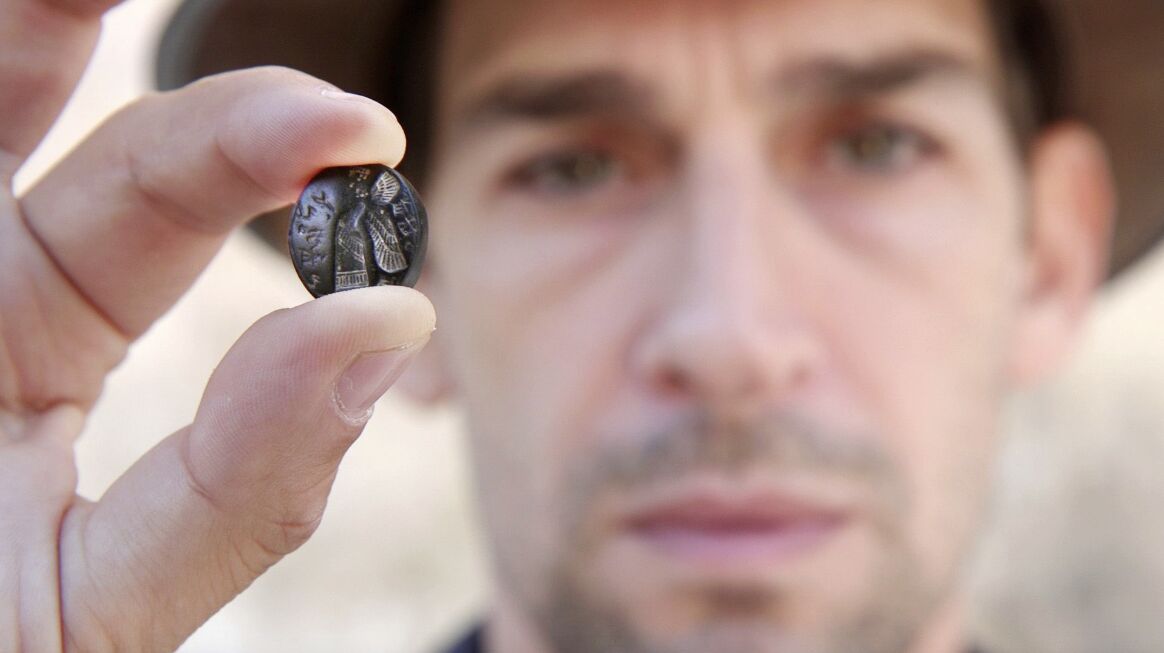Hundreds of First Temple Period bullae—stamped clay seal impressions—have been discovered in archaeological excavations in Jerusalem. Much rarer is the discovery of the actual stone seals used to make such impressions. Still, Jerusalem stands head and shoulders above all the cities in this region, domestic and foreign, with the number of epigraphic Iron Age seals thus far discovered—roughly three dozen. In contrast, the next-highest Judean city, Arad, has yielded five; Judah’s “second city,” Lachish, four. Quantitatively, this speaks to the administrative importance of this capital city.
Another First Temple Period seal has been found in Jerusalem, and it bears a fascinating inscription—with a potential biblical connection.

Unveiled last Thursday in a press release, the black stone seal—characterized as “extremely rare and unusual”—was discovered during the Israel Antiquities Authority (iaa) and City of David organization excavations along the southern wall of the Temple Mount. “The seal, made of black stone, is one of the most beautiful ever discovered in excavations in ancient Jerusalem and is executed at the highest artistic level,” said excavation directors Dr. Yuval Baruch and Navot Rom.
The seal is dated to the latter part of the First Temple Period and bears a winged figure framed by a paleo-Hebrew inscription reading, “Belonging to Yehoezer, son of Hoshayahu.” The hole drilled through its length would have allowed it to have been worn on a chain around the neck. An object like this, with mirrored writing, would have been used both as an amulet and to “sign,” or stamp, legal documents.
Israel Antiquities Authority archaeologist and Assyriologist Dr. Filip Vukosavović, who studied the seal, said:
This is an extremely rare and unusual discovery. This is the first time that a winged “genie”—a protective magical figure—has been found in Israeli and regional archaeology. Figures of winged demons are known in the Neo-Assyrian art of the ninth–seventh centuries b.c.e., and they were considered a kind of protective demon.
“The figure of a winged man in a distinct Neo-Assyrian style is unique and very rare in the glyphic styles of the late First Temple Period. The influence of the Assyrian Empire, which had conquered the entire region, is clearly evident here,” noted Dr. Baruch. It is surmised that “originally the demon image alone appeared, [and] was worn as an amulet around the neck of a man named Hoshʼayahu, who held a senior position in the kingdom of Judah’s administration,” according to the press release. Later, his son—Yehoezer—“inherited the seal, and then added his name and his father’s name on either side of the demon. This he did, perhaps, to directly appropriate to himself the beneficial qualities he believed the talisman embodied as a magical item.” This would explain the comparatively cruder text that was applied, as opposed to the more finely executed figure in the center.
Who might this Yehoezer, son of Hoshayahu, have been?
The book of Jeremiah “describ[es] the events of this very period,” the press release explains. Jeremiah 43:2 mentions a prominent figure by the name of “Azariah the son of Hoshaiah,” one of the “proud men” of Judah who rejected the words of the prophet. This would be an interesting potential fit for the “Yehoezer son of Hoshayahu.”
The names of the fathers are one and the same (note that the “yahu” ending, יהו, is simply a longer form of “iah,” יה, and is often used interchangeably). While the names of the sons appear quite different in English, they are closely related in Hebrew, effectively identical in meaning (“Yahweh aids”)—with one form having the theophoric, divine “Yahwist”-element (יהו) at the start of the name, and one at the end (עזריהו vs. יהועזר).
If this seal does indeed belong to this biblical figure, it would be one of a growing number of such seals and bullae already discovered on excavations referring to biblical figures, including: Hezekiah, Ahaz, Jeroboam, Isaiah, Nathan-Melech, Jehucal, Shelemiah, Gedaliah, Pashur, Gemariah, Shaphan, Azariah, Hilkiah, Eliakim, and another Hilkiah.
According to Prof. Ronny Reich from the University of Haifa, a research partner, “[c]omparing the shape of the letters and the writing to those of other Hebrew seals and bullae (clay seal impressions) from Jerusalem shows that, in contrast to the careful engraving of the demon, inscribing the names on the seal was done in a sloppy manner. It is not impossible that perhaps it was Yehoʼezer himself who engraved the names on the object.”
“This is further evidence of the reading and writing abilities that existed in this period,” says Dr. Baruch. “Contrary to what may be commonly thought, it seems that literacy in this period was not the realm only of society’s elite. People knew how to read and write—at least at the basic level, for the needs of commerce. We know of many written seal impressions, in paleo-Hebrew script, from the environs of the City of David and the Kingdom of Judah.”
More information will be presented to the public on September 4, at the 25th annual City of David Research Conference.


